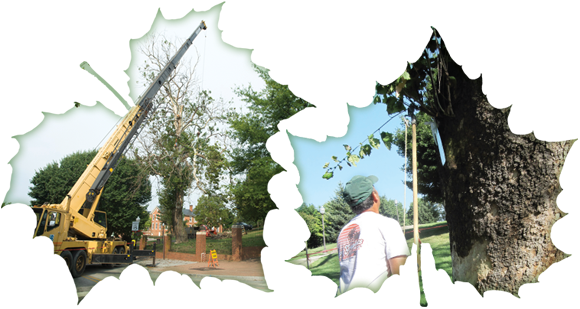HOW TECH TICKS
The Henderson Lawn sycamore tree had witnessed at least 140 years of Virginia Tech and Blacksburg life when the Arboretum Committee recommended in 2010 that the tree had to be removed. One of the oldest trees on campus, the sycamore was suffering from a chronic fungal disease known as anthracnose and had become a danger to nearby people and structures.

John Seiler, Alumni Distinguished Professor and the Honorable and Mrs. Shelton H. Short Jr. Professor of Forestry, and Eric Wiseman, associate professor of urban forestry and arboriculture, both in the College of Natural Resources and Environment, knew they had to act quickly. Neither were experts in the ancient practice of tree cloning known as "vegetative propagation," but the old sycamore held enough sentimental value that the two professors decided to do their best to replicate the historic tree. They collected approximately 300 specimens from the tree before it was dismantled, and they were able to produce two clones.

Seiler and Wiseman helped us visualize vegetative propagation.
1. Cut off a small leaf or twig. Trim the leaf so that the developing root system won't have to support as much leaf area.
2. Dip the stem in rooting powder, which uses growth hormones to convince the stem to grow roots. Unfortunately, the most effective mixtures are often closely guarded trade secrets.
3. Place the stem in soil, and use a misting system to keep the leaf moist around the clock.
Only about six of the clones showed promise in the greenhouse, and only two survived to be planted on campus. In the greenhouse, a special lighting regimen tricked the trees into perceiving a perpetual summer. The clones spent less than a year in greenhouses but experienced about three years of growth.
4. As they outgrew the greenhouse, the two sycamores were moved. Wiseman displayed another tree at the Urban Horticulture Center, where one of the clones grew for a year before being planted on Henderson Lawn.
5. The Henderson Lawn clone was dedicated at an April 22 ceremony attended by President Charles W. Steger (far left), Blacksburg Mayor Ron Rordam (M.A. history '79), and others.
6. The other clone was planted near Cheatham Hall during a 2011 graduation ceremony for the College of Natural Resources and Environment, an annual tradition. Here, Seiler (left) and Wiseman check its health.
The trees are copies, or identical twins, of the old sycamore. The new trees even look the same, with the same number of branches growing from the trunk at the same angles and lengths.
Produced by University Relations